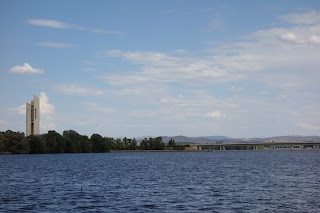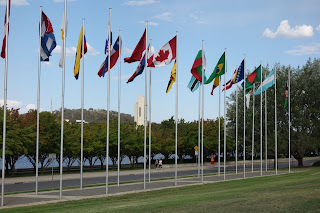The bridge you see here is Commonwealth Avenue Bridge, one of only two bridges that cross over Lake Burley Griffin. Commonwealth Bridge forms one side of the Parliamentary area with Kings Avenue Bridge (coming up in another photo) forming the other side.
Commonwealth Park is on the north side of the lake and it has an area of about 34.5 hectares. The main building in Commonwealth Park (seen here) is the National Capital Exhibition, which is sort of a mini-museum highlighting the people, events, history and design that contributed to the development of the uniqueness of Australia's capital city. The Captain Cook Waterjet is a very prominent feature in Lake Burley Griffin and it is situated just off the shore of Commonwealth Park. It is part of a memorial built to commemorate the Bicentenary of Captain James Cook's first sighting of the east coast of Australia in 1770, and in 1970 Queen Elizabeth II officially inaugurated the memorial. The water jet is powered by two 560 kilowatt electric motors driving four stage centrifugal pumps capable of pumping up to 250 litres per second. The main jet throws approximately six tons of water into the air at any instant, reaching a maximum height of 147 metres.(In periods of high wind the jet is automatically disabled as water landing on the nearby Commonwealth Avenue Bridge can be a hazard to traffic.)
Just to the left of the waterjet you might be able to see a flagpole - the Canadian flagpole actually! The flagpole was a gift given to Australia in 1955 by the Honourable C. D. Howe (nope, no relation, or at least not that I know of anyway), Minister of Trade and Commerce, on behalf of the Government of Canada. It is a single spar of Douglas Fir, logged from a forest in British Columbia. It is 39 metres tall with 3 metres in the ground and 36 metres freestanding. Due to the considerable technical challenges of transporting the pole from Canada to Australia by sea and then overland by rail to Canberra, the flagpole was not installed until November 1957. And now today, the Canadian flag is flown on this flagpole on July 1st every year.
Here you can see Kings Avenue Bridge and to the left is the National Carillon.
The carillon was a gift from the British government to the people of Australia to commemorate the 50th anniversary of the National Capital, and Queen Elizabeth II officially opened the National Carillon during her visit in 1970. Carillons must have a minimum of 23 bells, so this one with 55 bronze bells is quite large by world standards. The pitch of the bells ranges chromatically through four and one half octaves. The bells each weigh between seven kilograms and six tonnes. The design of the tower comprises three angular columns clad in striking quartz and opal chip. Each shaft is a triangle in plan and each is aligned with one of the three sides of a central equilateral triangle. With the tower rising to a height of 50 metres, this allows the music of the bells to drift across Lake Burley Griffin and through the surrounding parklands.
Carillonists play the suspended stationary bells from a keyboard of wooden batons and pedals, called a clavier. A system of individual cables and wire linkages draws soft iron clappers on to the bells as each wooden baton or pedal is struck by the carillonist. Carillon 'schools' are well established in Europe, with some in North America, and carillonists regularly participate in international recitals.
Being out in the middle of Lake Burley Griffin gave me the opportunity to see many of the National building and institutions here in Canberra from a different perspective.
Here is the back of High Court, with some of the display of international flags that line the lake shoreline. There is one flag for each nation with a diplomatic mission in the capital, as well flags include those of the United Nations, European Union and the Holy See.
Here is Old Parliament House, with Parliament House behind it. In the foreground is an area along the shoreline called Commonwealth Place. Speakers Square, at the centre of Commonwealth Place is a concave shaped grassed area with a paved mural in the middle which was a gift to Australia from the Government of Canada to mark the Centenary of Australian Federation in 2001. The gift symbolizes the shared experiences of people of all nations, living together as one under the heavens. The design (which you cannot see in my photos unfortunately) depicts the night skies of September in both the northern and southern hemispheres, joined together by curved bands representing the common aspirations and values that unite all people. It is symbolic of the long-standing friendship between Canada and Australia.
I couldn't fit it all in one photo - but if you were looking at the shoreline of the Parliamentary area you would see, from left to right (top photo first and then the bottom one):
the High Court (and the National Gallery is to the left again of the High Court but not quite visible from the lake), the international flag display with Commonwealth Place behind them and the two Parliament buildings behind that, then the National Science and Technology Centre, commonly called Questacon, is the white building with the cylindrical top, and to the right of that is the National Library of Australia.
Back on land again and I walked along the Australian of the Year Walk. It is a permanent record of those Australians selected as Australian of the Year, Senior Australian of the Year, Young Australian of the Year and Local Hero. Incorporated in the pathway are five metal strips, for the five stave lines to a music score. The plinths represent the notes to the music score of Advance Australia Fair, Australia's national anthem. (I thought this was incredibly creative!)
Peace Park, also along the foreshore, is nestled between a grove of trees and bushes. It was commissioned during 1986, the United Nations Year of Peace. The centre of the park has a square granite plinth with a peace symbol in it, surrounded by a quartered plinth incised with the word Peace written in the official languages of the United Nations and also the language of the local Ngunnawal people, and a statement of dedication. This is bordered by a water way fountain, and a cobbled granite walk way, with formal gardens of lavender at each corner. The monument's statement of dedication says, "All who visit here are invited to commit themselves to peace and the elimination of weapons of mass destruction"
I'm not sure if I'll have time to visit the National Library or not, but it is also one of Canberra's National institutions. The Library contains a collection totalling over 10,416,119 materials, stored on 250 kms of shelving. The origins of the National Library of Australia go back to the early years after Australian Federation in 1901, when the Commonwealth Parliamentary Library served both Federal Parliament and the nation. In 1927 the Library was moved from Melbourne to Canberra with the relocation of Parliament. An Act of Parliament in 1960 formally separated the National Library from the Parliamentary Library and a new building for the National Library’s growing collections and services was opened on the shores of Lake Burley Griffin, in 1968.
There are some lovely public art works all around the grounds of the National Library
including this particular one, Two Piece Reclining Figure No. 9, by Henry Moore. This cast-bronze sculpture was installed in 1970 and the scale is just over life-size because Moore wanted his works to "stand out-of-doors and be seen in a natural setting, and figures seen out-of-doors always look slightly smaller than they are".
And here ends my day walking around the Parliamentary area in Canberra.













No comments:
Post a Comment